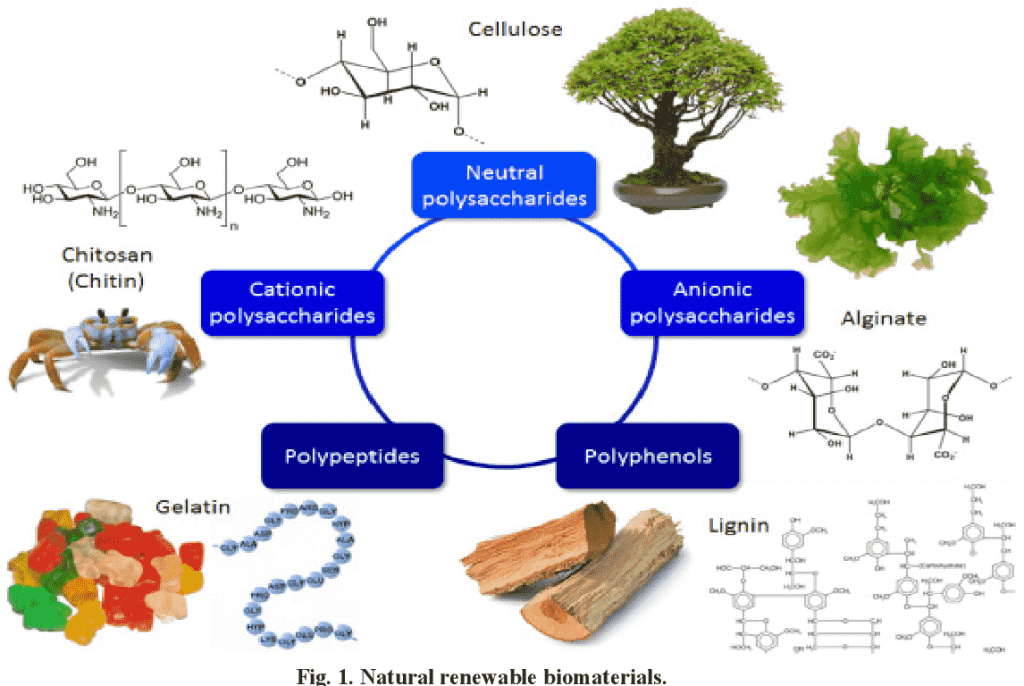Biopolymers are polymers produced by living organisms; in other words, they are polymeric biomolecules. Biopolymers contain monomeric units that are covalently bonded to form larger structures. There are three main classes of biopolymers, classified according to the monomeric units used and the structure of the biopolymer formed: polynucleotides (RNA and DNA), which are long polymers composed of 13 or more nucleotide monomers; polypeptides, which are short polymers of amino acids; and polysaccharides, which are often linear bonded polymeric carbohydrate structures.[1][2][3][4] Other examples of biopolymers include rubber, suberin, melanin and lignin.
Cellulose is the most common organic compound and biopolymer on Earth. About 33 percent of all plant matter is cellulose. The cellulose content of cotton is 90 percent, for wood it is 50 percent.

Biopolymers versus synthetic polymers
A major defining difference between biopolymers and synthetic polymers can be found in their structures. All polymers are made of repetitive units called monomers. Biopolymers often have a well-defined structure, though this is not a defining characteristic (example: lignocellulose): The exact chemical composition and the sequence in which these units are arranged is called the primary structure, in the case of proteins. Many biopolymers spontaneously fold into characteristic compact shapes (see also “protein folding” as well as secondary structure and tertiary structure), which determine their biological functions and depend in a complicated way on their primary structures. Structural biology is the study of the structural properties of the biopolymers. In contrast, most synthetic polymers’ have much simpler and more random (or stochastic) structures. This fact leads to a molecular mass distribution that is missing in biopolymers. In fact, as their synthesis is controlled by a template-directed process in most in vivo systems, all biopolymers of a type (say one specific protein) are all alike: they all contain the similar sequences and numbers of monomers and thus all have the same mass. This phenomenon is called monodispersity in contrast to the polydispersity encountered in synthetic polymers. As a result, biopolymers have a polydispersity index of 1.
Conventions and nomenclature
Polypeptides
The convention for a polypeptide is to list its constituent amino acid residues as they occur from the amino terminus to the carboxylic acid terminus. The amino acid residues are always joined by peptide bonds. Protein, though used colloquially to refer to any polypeptide, refers to larger or fully functional forms and can consist of several polypeptide chains as well as single chains. Proteins can also be modified to include non-peptide components, such as saccharide chains and lipids.
Nucleic acids
The convention for a nucleic acid sequence is to list the nucleotides as they occur from the 5′ end to the 3′ end of the polymer chain, where 5′ and 3′ refer to the numbering of carbons around the ribose ring which participate in forming the phosphate diester linkages of the chain. Such a sequence is called the primary structure of the biopolymer.
Sugar
Sugar-based biopolymers are often difficult with regards to convention. Sugar polymers can be linear or branched and are typically joined with glycosidic bonds. The exact placement of the linkage can vary, and the orientation of the linking functional groups is also important, resulting in α- and β-glycosidic bonds with numbering definitive of the linking carbons’ location in the ring. In addition, many saccharide units can undergo various chemical modifications, such as amination, and can even form parts of other molecules, such as glycoproteins.
Structural characterization
There are a number of biophysical techniques for determining sequence information. Protein sequence can be determined by Edman degradation, in which the N-terminal residues are hydrolyzed from the chain one at a time, derivatized, and then identified. Mass spectrometer techniques can also be used. Nucleic acid sequence can be determined using gel electrophoresis and capillary electrophoresis. Lastly, mechanical properties of these biopolymers can often be measured using optical tweezers or atomic force microscopy. Dual-polarization interferometry can be used to measure the conformational changes or self-assembly of these materials when stimulated by pH, temperature, ionic strength or other binding partners.
As materials
Some biopolymers- such as PLA, naturally occurring zein, and poly-3-hydroxybutyrate can be used as plastics, replacing the need for polystyrene or polyethylene based plastics.
Some plastics are now referred to as being ‘degradable’, ‘oxy-degradable’ or ‘UV-degradable’. This means that they break down when exposed to light or air, but these plastics are still primarily (as much as 98 per cent) oil-based and are not currently certified as ‘biodegradable’ under the European Union directive on Packaging and Packaging Waste (94/62/EC). Biopolymers will break down, and some are suitable for domestic composting.[9]
Biopolymers (also called renewable polymers) are produced from biomass for use in the packaging industry. Biomass comes from crops such as sugar beet, potatoes or wheat: when used to produce biopolymers, these are classified as non food crops. These can be converted in the following pathways:
Sugar beet > Glyconic acid > Polyglyconic acid
Starch > (fermentation) > Lactic acid > Polylactic acid (PLA)
Biomass > (fermentation) > Bioethanol > Ethene > Polyethylene
Many types of packaging can be made from biopolymers: food trays, blown starch pellets for shipping fragile goods, thin films for wrapping.
Environmental impacts
Biopolymers can be sustainable, carbon neutral and are always renewable, because they are made from plant materials which can be grown indefinitely. These plant materials come from agricultural non food crops. Therefore, the use of biopolymers would create a sustainable industry. In contrast, the feedstocks for polymers derived from petrochemicals will eventually deplete. In addition, biopolymers have the potential to cut carbon emissions and reduce CO2 quantities in the atmosphere: this is because the CO2 released when they degrade can be reabsorbed by crops grown to replace them: this makes them close to carbon neutral.
Biopolymers are biodegradable, and some are also compostable. Some biopolymers are biodegradable: they are broken down into CO2 and water by microorganisms. Some of these biodegradable biopolymers are compostable: they can be put into an industrial composting process and will break down by 90% within six months. Biopolymers that do this can be marked with a ‘compostable’ symbol, under European Standard EN 13432 (2000). Packaging marked with this symbol can be put into industrial composting processes and will break down within six months or less. An example of a compostable polymer is PLA film under 20μm thick: films which are thicker than that do not qualify as compostable, even though they are “biodegradable”.[10] In Europe there is a home composting standard and associated logo that enables consumers to identify and dispose of packaging in their compost heap.


